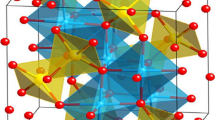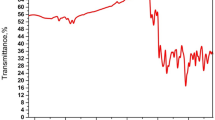Abstract
A series of porous carbon materials with wide range of specific surface areas and different heteroatom contents had been prepared using polyaniline as carbon precursor and KOH as an activating agent. Effect of surface area and heteroatom of porous carbon materials on specific capacitance was investigated thoroughly in two typical aqueous KOH and organic 1-butyl-3-methylimidazolium tetrafluoroborate/acetonitirle electrolytes. The different trends of capacitance performance were observed in these two electrolytes. Electrochemical analyses suggested that the presence of faradaic interactions on heteroatom-enriched carbon materials in organic environment is less significant than that observed in aqueous electrolytes. Thus, in aqueous electrolyte, a balance between surface area and heteroatom content of activated porous carbon would be found to develop a supercapacitor with high energy density. In organic electrolyte, the capacitance performance of porous carbon is strongly dependent on the surface area. The results may be useful for the design of porous carbon-based supercapacitor with the desired capacitive performance in aqueous and organic electrolytes.
Similar content being viewed by others
References
Winter M, Brodd RJ. What are batteries, fuel cells, and supercapacitors. Chem Rev, 2004, 104: 4245–4270
Zhai YP, Dou YQ, Zhao DY, Fulvio PF, Mayes RT, Dai S. Carbon materials for chemical capacitive energy storage. Adv Mater, 2011, 23: 4828–4850
Pandolfo AG, Hollenkamp AF. Carbon properties and their role in supercapacitors. J Power Sources, 2006, 157: 11–27
Liang CD, Li ZJ, Dai S. Mesoporous carbon materials: synthesis and modification. Angew Chem Int Ed, 2008, 47: 3696–3717
Miller JR, Outlaw RA, Holloway BC. Graphene double-layer capacitor with ac line-filtering performance. Science, 2010, 24: 1637–1639
Zhu YW, Murali S, Stoller MD, Ganesh KJ, Cai WW, Ferreira PJ, Pirkle A, Wallace RM, Cychosz KA, Thommes M, Su D, Stach EA, Ruoff RS. Carbon-based supercapacitors produced by activation of graphene. Science, 2011, 332: 1537–1541
Wang RT, Wang PY, Yan XB, Lang JW, Peng C, Xue QJ. Promising porous carbon derived from celtuce leaves with outstanding supercapacitance and CO2 capture performance. ACS Appl Mater Interfaces, 2012, 4: 5800–5806
Jurcakova DH, Kodama M, Shiraishi S, Hatori H, Zhu ZH, Lu GQ. Nitrogen-enriched nonporous carbon electrodes with extraordinary supercapacitance. Adv Funct Mater, 2009, 19: 1800–1809
Górka J, Jaroniec M. Hierarchically porous phenolic resin-based carbons obtained by block copolymer-colloidal silica templating and post-synthesis activation with carbon dioxide and water vapor. Carbon, 2011, 49: 154–160
Chen H, Zhang X, Zhang HT, Sun XZ, Zhang DC, Ma YW. High-performance supercapacitors based on a graphene-activated carbon composite prepared by chemical activation. RSC Adv, 2012, 2: 7747–7753
Wang Q, Yan J, Xiao Y, Wei T, Fan ZJ, Zhang ML, Jing XY. Interconnected porous and nitrogen-doped carbon network for supercapacitors with high rate capability and energy density. Electrochim Acta, 2013, 114: 165–172
Lv Y, Zhang F, Dou Y, Zhai YQ, Wang JX, Liu HJ, Xia YY, Tu B, Zhao DY. A comprehensive study on KOH activation of ordered mesoporous carbons and their supercapacitor application. J Mater Chem, 2012, 22: 93–99
Chmiola J, Yushin G, Gogotsi Y, Portet C, Simon P, Taberna PL. Anomalous increase in carbon capacitance at pore sizes less than 1 nanometer. Science, 2006, 313: 1760–1763
Chmiola J, Largeot C, Taberna PL, Simon P, Gogotsi Y. Desolvation of ions in subnanometer pores and its effect on capacitance and double-layer theory. Angew Chem Inte Ed, 2008, 47: 3392–3395
Feng G, Cummings PT. Supercapacitor capacitance exhibits oscillatory behavior as a function of nanopore size. J Phys Chem Lett, 2011, 2: 2859–2864
Huang J, Sumpter BG, Meunier V. Theoretical model for nanoporous carbon supercapacitors. Angew Chem Int Ed, 2008, 47: 520–524
Kondrat S, Perez CR, Presser V, Gogotsi Y, Kornyshev AA. Effect of pore size and its dispersity on the energy storage in nanoporous supercapacitors. Energy Environ Sci, 2012, 5: 6474–6479
Wang RT, Yan XB. Superior asymmetric supercapacitor based on Ni-Co oxide nanosheets and carbon nanorods. Sci Rep, 2014, 4: 3721
Zhang L, Ying X, Zhang F, Long GK, Zhang TF, Leng K, Zhang YW, Huang Y, Ma YF, Zhang MT, Chen YS. Controlling the effective surface area and pore size distribution of sp2 carbon materials and their impact on the capacitance performance of these materials. J Am Chem Soc, 2013, 13: 5921–5929
Zhang LL, Zhao X, Ji H, Stoller MD, Lai L, Murali S, Mcdonnell S, Cleveqer B, Wallace RM, Ruoff RS. Nitrogen doping of graphene and its effect on quantum capacitance, and a new insight on the enhanced capacitance of N-doped carbon. Energy Environ Sci, 2012, 5: 9618–9625
Zhong M, Kim EK, McGann JP, Chun SE, Whitacre JF, Jaroniec M, Matyjaszewski K, Kowalewski T. Electrochemically active nitrogen-enriched nanocarbons with well-defined morphology synthesized by pyrolysis of self-assembled block copolymer. J Am Chem Soc, 2012, 134: 14846–14857
Sevilla M, Valle-Vigón P, Fuertes AB. N-doped polypyrrole-based porous carbons for CO2 capture. Adv Funct Mater, 2011, 21: 2781–2787
Qie L, Chen WM, Wang ZH, Zhao QG, Li X, Yuan LX, Lu XL, Zhang WX, Huang YH. Nitrogen-doped porous carbon nanofiber webs as anodes for lithium ion batteries with a superhigh capacity and rate capability. Adv Mater, 2012, 24: 2047–2050
Zhao L, Fan LZ, Zhou MQ, Guan H, Qiao S, Antonietti M, Titirici MM. Nitrogen-containing hydrothermal carbons with superior performance in supercapacitors. Adv Mater, 2010, 22: 5202–5206
Hulicova D, Kodama M, Hatori H. Electrochemical performance of nitrogen-enriched carbons in aqueous and non-aqueous supercapacitors. Chem Mater, 2006, 18: 2318–2326
Ania CO, Khomenko V, Raymundo-Piñero E, Parra JB, Béguin F. The large electrochemical capacitance of microporous doped carbon obtained by using a zeolite template. Adv Funct Mater, 2007, 17: 1828–1836
Andreas HA, Conway BE. Examination of the double-layer capacitance of an high specific-area C-cloth electrode as titrated from acidic to alkaline pHs. Electrochim Acta, 2006, 51: 6510–6520
Seredych M, Hulicova-Jurcakova D, Lu GQ, Bandosz TJ. Surface functional groups of carbons and the effects of their chemical character, density and accessibility to ions on electrochemical performance. Carbon, 2008, 46: 1475–1488
Jurewicz K, Pietrzak R, Nowicki P, Wachowska H. Capacitance behaviour of brown coal based active carbon modified through chemical reaction with urea. Electrochim Acta, 2008, 53: 5469–5475
Frackowiak E, Lota G, Machnikowski J, Vix-Guterl C, Beguin F. Optimisation of supercapacitors using carbons with controlled nanotexture and nitrogen content. Electrochim Acta, 2006, 51: 2209–2214
Qiu YC, Zhang XF, Yang SH. High performance supercapacitors based on highly conductive nitrogen-doped graphene sheets. Phys Chem Chem Phys, 2011, 13: 12554–12558
Qian WJ, Sun FX, Xu YH, Qiu LH, Liu CH, Wang SD, Yan F. Human hair-derived carbon flakes for electrochemical supercapacitors. Energy Environ Sci, 2014, 7: 379–386
An BG, Xu SF, Li LX, Tao J, Huang F, Geng X. Carbon nanotubes coated with a nitrogen-doped carbon layer and its enhanced electrochemical capacitance. J Mater Chem A, 2013, 1: 7222–7228
Hulicova-Jurcakova D, Kadama M, Shiraishi S, Hatori H, Zhu ZH, Lu GQ. Nitrogen-enriched nonporous carbon electrodes with extraordinary supercapacitance. Adv Funct Mater, 2009, 19: 1800–1809
Hulicova-Jurcakova D, Serdych M, Lu GQ, Bandosz TJ. Combined effect of nitrogen- and oxygen-containing functional groups of microporous activated carbon on its electrochemical performance in supercapacitors. Adv Funct Mater, 2009, 19: 438–447
Li X, Wang HL, Robinson JT, Sanchez H, Diankov G, Dai HJ. Simultaneous nitrogen doping and reduction of graphene oxide. J Am Chem Soc, 2009, 131: 15939–15944
Kim YJ, Abe Y, Yanagiura T, Park KC, Shimizu M, Iwazaki T, Nakagawa S, Endo M, Dresselhaus MS. Easy preparation of nitrogen-enriched carbon materials from peptides of silk fibroins and their use to produce a high volumetric energy density in supercapacitors. Carbon, 2007, 45: 2116–2125
Hulicova D, Yamashita J, Soneda Y, Hatori H, Kodama M. Supercapacitors prepared from melamine-based carbon. Chem Mater, 2005, 17: 1241–1247
Yan J, Wei T, Qiao WM, Fan ZJ, Zhang LJ, Li TY, Zhao QK. A high-performance carbon derived from polyaniline for supercapacitors. Electrochem Commun, 2010, 12: 1279–1282
Li LM, Liu EH, Yang YJ, Shen HJ, Huang ZZ, Xiang XX. Nitrogen-containing carbons prepared from polyaniline as anode materials for lithium secondary batteries. Mater Lett, 2010, 64: 2115–2117
Chen YZ, Zhu HY, Liu YN. Preparation of activated rectangular polyaniline-based carbon tubes and their application in hydrogen adsorption. Int J Hydrogen Energ, 2011, 36: 11738–11745
Yin JB, Xia X, Xiang LQ, Zhao XP. Conductivity and polarization of carbonaceous nanotubes derived from polyaniline nanotubes and their electrorheology when dispersed in silicone oil. Carbon, 2010, 48: 2958–2967
Wang J, Chen MM, Wang CY, Wang JZ, Zheng JM. Preparation of mesoporous carbons from amphiphilic carbonaceous material for high-performance electric double-layer capacitors. J Power Sources, 2011, 196: 550–558
Cuhadaraglu D, Uygun OA. Production and characterization of activated carbon from a bituminous coal by chemical activation. Afr J Biotechnol, 2008, 7: 3703–3710
Chen CM, Zhang Q, Yang MG, Huang CH, Yang YG, Wang MZ. Structural evolution during annealing of thermally reduced graphene nanosheets for application in supercapacitors. Carbon, 2012, 50: 3572–3584
Chen CM, Zhang Q, Zhao XC, Zhang BS, Kong QQ, Yang MG, Yang QH, Wang MZ, Yang YG, Schlogl R, Su DS. Hierarchically aminated graphene honeycombs for electrochemical capacitive energy storage. J Mater Chem, 2012, 22: 14076–14084
Oda H, Yamashita A, Minoura S, Okamoto M, Morimoto T. Modification of the oxygen-containing functional group on activated carbon fiber in electrodes of an electric double-layer capacitor. J Power Sources, 2006, 158: 1510–1516
Ruiz V, Blanco C, Granda M, Santamaría R. Enhanced life-cycle supercapacitors by thermal treatment of mesophase-derived activated carbons. Electrochim Acta, 2008, 54: 305–310
Author information
Authors and Affiliations
Corresponding author
Electronic supplementary material
Rights and permissions
About this article
Cite this article
Wang, R., Lang, J. & Yan, X. Effect of surface area and heteroatom of porous carbon materials on electrochemical capacitance in aqueous and organic electrolytes. Sci. China Chem. 57, 1570–1578 (2014). https://doi.org/10.1007/s11426-014-5123-x
Received:
Accepted:
Published:
Issue Date:
DOI: https://doi.org/10.1007/s11426-014-5123-x




